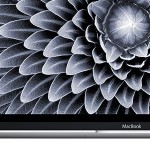When Steve Jobs first unveiled the MacBook Air in January 2008, reaction was decidedly mixed.
Few argued that, at 1.36kg and no more than 19mm thick, it was an impressive feat of engineering. But many pointed out that its middling specs made its $1,800+ pricetag absurd, while its lone USB port and lack of an optical drive meant its usability was severely hampered.
Seven years on, Apple has managed to kick of the exact same debate – this time around the new version of its mid-tier MacBook laptop.
Weighing just 900g and boasting a maximum thickness of just 13mm, the new MacBook is another fine example of Apple’s ability to maximise space.
Packed in amongst an array of batteries is a 12” ‘Retina Display’ screen, 256GB of SSD storage and 8GB of RAM – as well an interesting new keyboard, a new ‘taptic’ trackpad and some other bells and whistles (read: camera and speakers).
But in the process Apple has made what many would agree to be compromises – for example, the processor is just a 1.1GHz dual-core Intel Core M. At a starting price of $1,299, accusations of too-much-cost paired with too-little-power are being made once again.
Of course the success of the first MacBook Air proved that consumers are only marginally concerned about processor power. Far more important to them is convenience and portability – and, of course, style.
Apple has no reason to believe that this won’t also be the case with its new MacBook.
But even putting the price/power dynamic aside, many doubt that the new MacBook will have much appeal in light of another seeming compromise; that being the decision to reduce all wired connectivity – including the power cable – to one (USB-C) port.
This effectively means that people will need an adaptor if they want to plug in a regular USB device (even their little memory stick), if they want to use an external display or if they want to connect any two things at once.
Many say that the market is not yet ready for such a move, especially because USB-C is still in its infancy.
And they have a point; but Apple has long been adept at spotting a shift in the way people use their computers and adapting their product line before everyone else.
The first MacBook Air is a good example of that.
More than a few eyebrows were raised when that device shipped without a disc drive, but today that is a fairly common feature (or lack of a feature) in any company’s laptop line.
Apple saw that people were moving to USB and digital downloads, meaning their reliance on discs was diminishing rapidly. It took a punt and profited as a result.
With the new MacBook, they’re making a similar bet.
Apple sees that customers are becoming increasingly reliant on cloud services (i.e. iCloud Drive) to store and access their content. It sees wireless standards like Bluetooth and WiFi (and AirDrop) becoming increasingly common means of sharing files and connecting devices, and it reckons wireless will also become the norm for video and audio streaming (i.e. AirPlay).
With all that in mind, Apple is taking a punt and hoping that once people acquire a new MacBook, they’ll realise just how little they needed all of the ports on their old laptop.
(It’s no harm to their business model that the best way to ensure that, will be through the ownership of multiple Apple devices.)
MacBook vs MacBook Air
But even with that justification, there is still a bit of confusion about the MacBook – specifically its relationship to the existing MacBook Air range.
It has effectively stolen the emperor’s clothes, coming in thinner and lighter than its “little” brother, leading many to wonder why it didn’t replace – rather than supplement – the ‘Air’.
An answer to that may come in the next big product announcement Apple is rumoured to be making.
By all accounts, the company will take the wraps off a new ‘iPad Pro’ later this year as it seeks to arrest the decline in tablet sales while also increasing its courtship of the business market.
The device will be larger than the existing iPad Air, with a focus on higher-end and more work-focused use. Some have even suggested that it device will include some laptop-esque features – like a USB(-C?) port to make it more appealing to such users.
If such a device were to be a hit, it would almost certainly be at the expense of some of Apple’s laptop market – particularly those looking for an ultraportable that can be used for day-to-day tasks.
In other words, it would take another big bite out of the MacBook Air’s raison d’etre. And that’s the prism through which the new MacBook should be viewed.
With it, Apple has taken the concept of the MacBook Air to a new extreme and pushed it up the value chain in the process.
This leaves space for Apple to replace the ‘Air’ with a high-end, tablet/laptop hyprid iPad, without necessary losing too many of those who might still want the option of a dedicated, ultraportable laptop.
And it would hardly be the first time the company has tweaked its product line to make space for a new category. Just look at how it constantly shifted its iPod line-up over the years to make room for a new variant – and even how the square iPod Nano (which many users wore on their wrists) changed shape around the time Apple started looking into building a smartwatch…
